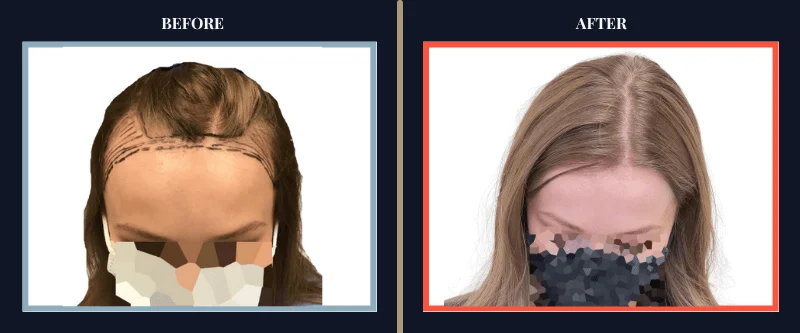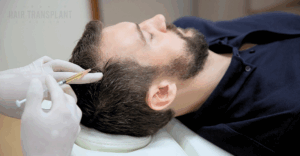
Hair loss can be a distressing experience for women, impacting their physical appearance and self-confidence. While often associated with men, hair loss affects nearly half of women by age 50. Female pattern hair loss typically manifests as thinning on the top of the head and at the temples. However, unlike men, women rarely experience complete baldness.
Fortunately, advances in hair restoration techniques have made female hair transplants an effective solution to reverse the signs of hair loss and improve a woman’s physical appearance by restoring and thickening the hair.
Understanding Female Hair Transplant
A female hair transplant is a surgical procedure that appeals to women experiencing thinning hair. It involves extracting healthy hair follicles from the donor area, typically the back of the scalp, and implanting them in the recipient area where hair is thinning. The procedure can restore the hair, fill in troublesome thinning areas, and improve self-image and confidence. Unlike some topical treatments, women’s hair transplant surgery provides a reliable and permanent solution to hair loss.
Determining Candidacy for Female Hair Transplant
Not all women are suitable candidates for a hair transplant procedure. To determine eligibility, patients should have healthy hair at their donor site, be in good physical and mental health, and have realistic expectations about the results. A thorough evaluation by a trusted surgeon is essential to assess the suitability of a female hair transplant candidate and create a tailored plan for each patient. This can be easily handled through our free consultation process. Female hair loss transplants are primarily suitable for androgenetic alopecia, a common genetic hair loss condition in women. Consulting a specialist determines suitability for other types of hair loss.
Benefits of Hair Transplant for Women
1. Restoring Hair Loss and Thickening Hair
A female hair transplant offers the opportunity to restore a natural-looking hairline and thicken the hair, resulting in a fuller and more youthful appearance.
2. Confidence Boost
Thinning hair can have a significant impact on a woman’s self-image and confidence. A successful hair transplant can fill in troublesome thinning areas, providing a significant boost in self-esteem.
3. Minimal Downtime
Compared to traditional strip graft methods, female hair transplants using techniques like Follicular Unit Excision (FUE) have minimal downtime. The initial recovery period typically lasts only 2 to 3 days, with mild pain and discomfort that subside quickly.
4. Permanent Hair Loss Solution
Female hair transplant surgery offers a permanent solution to hair loss. Since the transplanted hair follicles are taken from healthy sites at the back and sides of the head, they are genetically resistant to hair loss and will continue to grow naturally.
Risks and Complications of Female Hair Transplant
While complications are uncommon, it’s essential to be aware of potential risks associated with a female hair transplant. Choosing a trusted and experienced surgeon can help minimize these risks. Some potential complications include:
1. Bleeding and Swelling
Although less intrusive than strip graft methods, FUE female hair transplants may cause minor bleeding and swelling at the extraction sites. However, these side effects are temporary and easily managed. For a strip or FUT female hair transplant, an experienced surgeon can minimize the size and appearance of the resulting scar from the surgical incision and the post-surgery minimal discomfort.
2. Infection
Infection is extremely rare in hair transplant procedures, especially when performed by an experienced surgeon, and preventative antibiotics are used.
3. Are Hair Transplants Painful?
One thing that many people worry about as far as hair transplants are concerned is the pain factor. It’s a very understandable concern. We’re proud to offer the Pro-Nox anxiety and pain control system, one of the most advanced comfort measures available for hair transplant surgery. Pro-Nox is a system that delivers an inhaled mixture of nitrous oxide and oxygen. This mixture is highly effective at calming your nerves and minimizing the brief periods of discomfort during your surgery or procedure.
4. Healing Complications
To avoid damage to the transplanted hair follicles and ensure proper healing, the surgical team takes every precaution during the procedure and provides detailed instructions for post-op care. Our team also checks in with patients post-op to ensure their healing is on track and to answer any questions that may arise.
Different Types of Female Hair Transplants
During the initial consultation, the Toronto Hair Transplant Surgeons will determine the most suitable hair restoration technique based on each patient’s unique pattern of hair loss and factors like the quality and number of healthy donor hair follicles. Two existing methods of hair restoration surgeries for women are:
1. FUE (Follicular Unit Excision)
Follicular unit excision (sometimes referred to as extraction) is one of the two main types of hair transplant procedure performed today – the other being FUT (follicular unit transplant). In an FUE procedure, individual units of follicles are taken from the back and sides of the head and transplanted to the thinning areas.
2. FUT (Follicular Hair Transplant) or Strip Surgery
FUT strip surgery is often the best choice for female patients with extensive hair loss who require a large number of grafts. It is the best way to get the maximum number of healthy grafts within the same procedure.
Though the procedure does leave a small linear scar across the back of the head, the scar is usually minimized by a skilled surgeon. While this can become visible if someone wears their hair very short, it is usually covered by hair and hidden from sight.
Hair Replacement for Women: Non-Surgical Alternatives for Female Hair Loss
Apart from hair transplants, women have several other alternatives for managing female hair loss. Many factors contributing to hair loss in women respond well to non-surgical hair restoration programs. These alternatives include:
1. Low-level light laser therapy
Low-level light laser therapy stimulates hair follicles, making them more resistant to hair loss and stimulating the growth phase. This non-invasive treatment option can improve hair density and promote regrowth.
2. Caffeinated Shampoo
A shampoo containing stimulants and nutrients can be used to help stimulate blood flow to the scalp and boost the fullness of existing hair. This helps nourish the hair follicles and stimulate growth.
3. Minoxidil
Topical serums containing minoxidil can be applied to the scalp. This treatment increases blood supply and helps prevent further hair loss.
4. Injectable Growth Factors and Bio-stimulants (Platelet Rich Plasma – PRP)
Growth factors in the patient’s own blood can be injected into the scalp to revive dormant hairs and minimize ongoing hair loss.
The Female Hair Transplant Process
Female hair transplant procedures performed by skilled surgeons are effective in treating female pattern hair loss. These techniques offer several advantages, including minimal scarring and faster recovery times.
During the FUE procedure, individual follicles of hair are harvested from the donor area using a tiny punch. During the FUT procedure, your surgeon surgically removes a small strip from the scalp and then the follicles are separated under microscope. Localized numbing agents are administered to the transplant site, and tiny incisions are created between existing hairs to receive the transplanted grafts. This process is repeated until the entire target area has been treated.
Preparing for a Ladies Hair Transplant
To ensure a successful female hair transplant, specific instructions should be followed to aid recovery. Prior to the procedure:
- Avoid anti-inflammatory medications for at least one week.
- Refrain from consuming alcohol and smoking for one week.
- Avoid eating after midnight on the night before the surgery.
On the day of the surgery, thoroughly wash the hair with shampoo and conditioner.
Post-FUE Female Hair Transplant Surgery Recovery
Compared to traditional strip graft methods, female hair transplants using FUE offer faster recovery times and minimal discomfort. The recovery process typically follows this timeline:
- Day 2-3: Mild pain and discomfort subside, allowing low-impact daily activities to be resumed.
- Day 3-4: Swelling begins to subside or has resolved completely.
- Day 5-7: Most patients can return to work.
- Week 4: Regular exercise activities can be resumed.
It’s important to note that final results may take up to 12-18 months to fully manifest. The success rate of hair transplant results for women is generally high when performed by experienced surgeons. However, individual factors like health, post-operative care, and adherence to aftercare instructions can influence outcomes.
Female Hair Restoration
About 10 to 20% of the hair transplants we perform are on female patients. Hair loss in female patients affect 50% of females over the age of 50. Males can disguise hair loss by shaving their head but for females, hair loss is harder to hide and is almost always a source of embarrassment. Fortunately, there are now more solutions available for females. Minoxidil, cosmetic hair thickeners like Instant Hair, low-level laser therapy are all options available to patients and can be treatments to try before resorting to hair transplantation.
Female Hair Transplant FAQs
What services does a female hair loss clinic typically offer?
Female hair loss clinics provide comprehensive evaluations and a range of treatments like PRP therapy, medications, and surgical options tailored for women.
Is FUE hair transplant suitable for women experiencing hair thinning?
Yes, FUE hair transplant women is a minimally invasive technique suitable for women experiencing hair thinning. It involves extracting individual follicles for transplantation, which is ideal for targeted treatment.
How long do female hair transplants last?
Hair implants from a transplant are permanent. The transplanted hair grows naturally and remains for a lifetime.
What factors determine the cost of hair transplant surgery for females?
The cost of hair transplant surgery for females depends on various aspects, such as the chosen surgical technique, the clinic’s location, the surgeon’s expertise, and the extent (number of grafts) of the procedure required.
Conclusion
Hair loss can be a distressing experience for women, impacting their self-image and confidence. Fortunately, female hair transplants offer a reliable and permanent solution to reverse the signs of hair loss, restore the areas of hair loss and thicken the hair. Women can achieve natural-looking results and regain self-confidence by selecting a trusted surgeon like those at Toronto Hair Transplant Surgeons. Whether opting for a surgical procedure or exploring non-surgical alternatives, women have various options to address their hair loss concerns. With advancements in technology and techniques, female hair transplants have become less invasive, ensuring minimal downtime and faster recovery.
If you are a female experiencing hair loss and looking for solutions, please contact us or use this link to book a free consultation and we can your best options with you.





